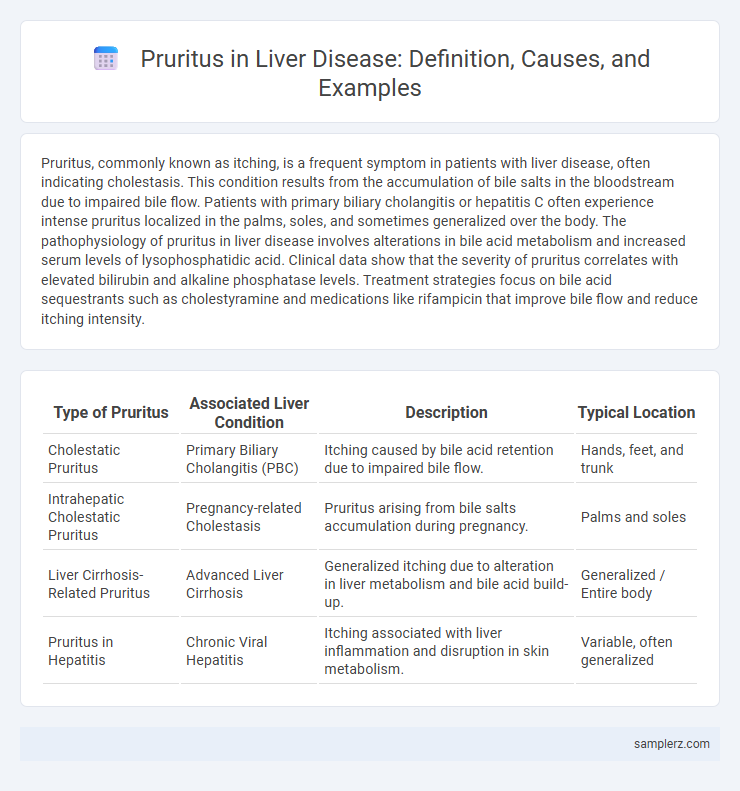Pruritus, commonly known as itching, is a frequent symptom in patients with liver disease, often indicating cholestasis. This condition results from the accumulation of bile salts in the bloodstream due to impaired bile flow. Patients with primary biliary cholangitis or hepatitis C often experience intense pruritus localized in the palms, soles, and sometimes generalized over the body. The pathophysiology of pruritus in liver disease involves alterations in bile acid metabolism and increased serum levels of lysophosphatidic acid. Clinical data show that the severity of pruritus correlates with elevated bilirubin and alkaline phosphatase levels. Treatment strategies focus on bile acid sequestrants such as cholestyramine and medications like rifampicin that improve bile flow and reduce itching intensity.
Table of Comparison
| Type of Pruritus | Associated Liver Condition | Description | Typical Location |
|---|---|---|---|
| Cholestatic Pruritus | Primary Biliary Cholangitis (PBC) | Itching caused by bile acid retention due to impaired bile flow. | Hands, feet, and trunk |
| Intrahepatic Cholestatic Pruritus | Pregnancy-related Cholestasis | Pruritus arising from bile salts accumulation during pregnancy. | Palms and soles |
| Liver Cirrhosis-Related Pruritus | Advanced Liver Cirrhosis | Generalized itching due to alteration in liver metabolism and bile acid build-up. | Generalized / Entire body |
| Pruritus in Hepatitis | Chronic Viral Hepatitis | Itching associated with liver inflammation and disruption in skin metabolism. | Variable, often generalized |
What Is Pruritus in Liver Disease?
Pruritus in liver disease manifests as intense itching caused by the accumulation of bile salts in the skin due to impaired bile flow or cholestasis. Conditions such as primary biliary cholangitis, primary sclerosing cholangitis, and hepatitis can lead to this symptom by disrupting normal liver function. Effective management requires addressing the underlying liver disorder and alleviating itching with medications like bile acid sequestrants or antihistamines.
Common Liver Conditions Linked to Pruritus
Cholestasis is a common liver condition linked to pruritus, caused by the impaired flow of bile acids leading to their accumulation in the bloodstream and triggering intense itching. Primary biliary cholangitis (PBC) and primary sclerosing cholangitis (PSC) are autoimmune liver diseases frequently associated with persistent pruritus due to bile duct damage and cholestasis. Hepatitis C and cirrhosis also contribute to pruritus through metabolic disturbances and liver dysfunction affecting bile acid metabolism.
How Does Liver Dysfunction Cause Itching?
Liver dysfunction causes itching, or pruritus, primarily due to the accumulation of bile salts in the bloodstream when bile flow is impaired. Conditions such as cholestasis and cirrhosis lead to elevated levels of bile acids, which deposit in the skin and stimulate nerve endings, triggering intense itching. This mechanism is often observed in chronic liver diseases like primary biliary cholangitis and hepatitis, where impaired bile secretion disrupts normal excretion pathways.
Symptoms of Pruritus in Liver Disorders
Pruritus in liver disorders often manifests as intense, persistent itching primarily affecting the palms and soles, sometimes spreading to the limbs and trunk. This symptom is frequently associated with cholestasis, where impaired bile flow leads to the accumulation of bile salts in the bloodstream, triggering nerve endings in the skin. Patients may also experience dryness, scaling, or excoriations resulting from vigorous scratching, which can exacerbate skin irritation and discomfort.
Primary Biliary Cholangitis: A Key Example
Pruritus in liver disease is prominently exemplified by Primary Biliary Cholangitis, a chronic autoimmune condition characterized by progressive bile duct destruction and cholestasis. This cholestatic pruritus results from elevated serum bile acids and accumulation of pruritogenic substances such as lysophosphatidic acid. Effective management includes ursodeoxycholic acid therapy, which improves bile flow and reduces itch intensity, alongside symptomatic treatments targeting the underlying cholestasis.
Pruritus in Primary Sclerosing Cholangitis
Pruritus in Primary Sclerosing Cholangitis (PSC) is a common symptom caused by impaired bile flow and accumulation of bile salts in the skin. Patients with PSC often experience intense itching that worsens at night due to cholestasis-related elevation of serum bile acids. Management includes bile acid sequestrants, rifampicin, and in severe cases, liver transplantation to alleviate pruritus and improve quality of life.
Chronic Hepatitis and Skin Itching
Chronic hepatitis often causes pruritus due to the accumulation of bile acids in the bloodstream, which irritates nerve endings in the skin. This persistent itching, typically worsening at night, significantly impacts patients' quality of life and may require targeted treatments such as bile acid sequestrants. Monitoring liver function tests and addressing underlying inflammation in chronic hepatitis can help alleviate skin itching associated with hepatic pruritus.
Pruritus as an Early Sign of Liver Cirrhosis
Pruritus, characterized by intense itching without visible skin lesions, often serves as an early sign of liver cirrhosis due to bile salt accumulation in the bloodstream. This symptom is frequently observed in patients with primary biliary cholangitis and other cholestatic liver diseases. Early recognition of pruritus can prompt timely diagnostic evaluation and management of underlying hepatic dysfunction, potentially improving patient outcomes.
Diagnosis: Identifying Liver-Related Pruritus
Pruritus in liver disease often manifests due to cholestasis, where bile acid accumulation irritates nerve endings. Diagnosis involves measuring serum bile acids, liver function tests including ALT, AST, ALP, and bilirubin, and imaging studies like ultrasound or MRCP to detect bile duct obstruction. Identifying underlying conditions such as primary biliary cholangitis or autoimmune hepatitis is critical for targeted treatment of liver-related pruritus.
Managing and Treating Pruritus in Liver Patients
Pruritus in liver patients often manifests due to cholestasis, leading to intense itching caused by bile salt accumulation; managing this symptom requires targeted therapies such as bile acid sequestrants like cholestyramine or rifampicin to reduce serum bile acids. Treatment may also include antihistamines or opioid receptor antagonists like naltrexone to alleviate discomfort and improve quality of life. Close monitoring of liver function tests and underlying liver disease progression is essential for optimizing pruritus management and preventing complications.

example of pruritus in liver Infographic
 samplerz.com
samplerz.com